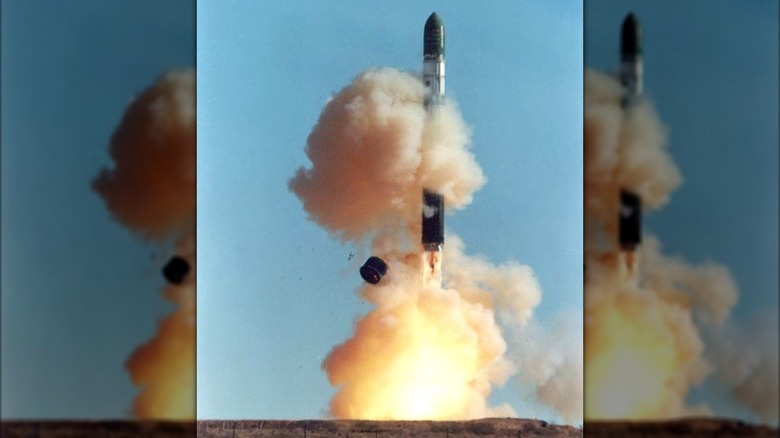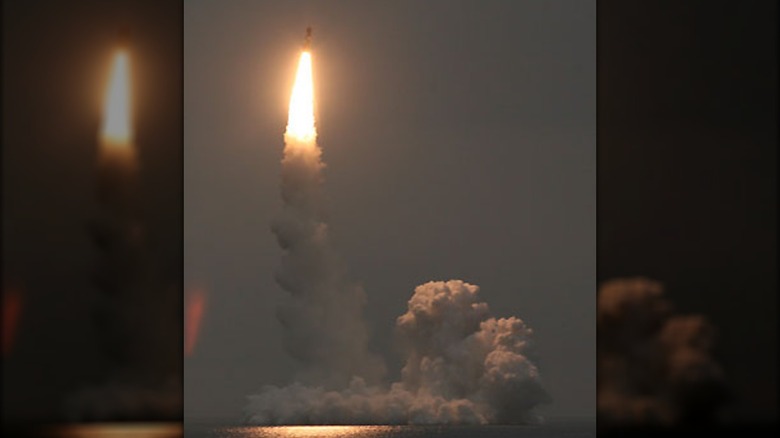How Long Would It Take For A Missile From Russia To Reach The US?
The first missile that was developed with the ability to travel across the world was the R-7 Semyorka, created by the Soviet Union and successfully tested in 1957. With its creation, the world changed from one requiring a great deal of effort to attack an enemy target to one merely pushing of a button. Granted, it's more complicated than that, but firing off an intercontinental ballistic missile (ICBM) is far easier than arming a strategic bomber, flying into enemy airspace, and dropping a bomb.
As time passed, ICBM technology developed by leaps and bounds, and it takes even less time to fire nukes at enemies. Because the Russian Federation remains an antagonist on the world stage, it's not uncommon to wonder how long it would take for a Russian missile to reach the United States. Of course, that's not a simple question to answer, as you have to take into account distance, technology, and more. For example, the closest distance between the coast of Alaska and Russia is only around 53 miles.
If Russia wanted to nuke a city like Washington D.C., that's another story, as the distance is significantly larger. Still, a good average amount of time for a Russian ICBM to strike a U.S. target is only 30 minutes. There are various platforms capable of delivering them at faster or slower speeds, but 30 minutes is the amount of time the U.S. has to work with to mount a response, whether it's a counter-missile attack or a retaliatory nuclear strike of its own.
Ground-based ICBM times
A ground-based ICBM is a massive, multi-stage ballistic missile that can be launched from underground silos or from mobile missile launch platforms, and Russia has both. In fact, the Russian nuclear arsenal is massive and possesses more warheads than the U.S. Regardless, there are numerous variables in determining the length of time needed for an ICBM to launch, fly to the target, reenter the atmosphere, and deploy its warheads. These phases are known as the boost phase, midcourse phase, and reentry or terminal phase.
The boost phase can take between three and five minutes, depending on the fuel used. After this, the missile travels for around 20 minutes in a sub-orbital flight, depending on its distance from the target. The reentry phase lasts around one minute, ending when the warheads detonate on or above the target. Because the details of launch facilities and the locations of mobile platforms are highly classified by all nations, drilling down into exact specifics isn't possible. Still, 30 minutes is a good estimate for any ground-based ICBM launched from Russia.
Russian ICBMs have impressive ranges, so they can be placed anywhere in the country and still reach the U.S. They could fly over the Arctic on their way to the States, though the same is true for U.S.-based missiles. For a missile to be considered an ICBM, it must travel a minimum of 3,418 miles, but the largest is Russia's silo-based R-36M, which can fly for approximately 9,942 miles. For reference, the distance between Moscow and Washington, D.C. is 4,860 miles.
Submarine-based ICBM times
During the Cold War, Russia threatened to stage nuclear-armed missiles in Cuba, resulting in the Cuban Missile Crisis. That would have put nukes on the lower 48's proverbial doorstep, as Havana is only 105 miles from Key West, Florida. These days, submarine missile-launch technology has rendered such a plan innocuous, as a well-operated strategic nuclear missile submarine, like the U.S.' Ohio-class subs, can linger off the coast of an enemy nation and fire a volley of nuclear-armed missiles at its targets.
Russia's RSM-56 Bulava is its submarine-launched ballistic missile (SLBM), which is capable of carrying nuclear warheads. They're carried by Borei-class submarines, and should they remain close to the U.S. coastline, shrouded in the depths, they could fire on the nation and hit its targets much faster than those launched from Russian territory. These three-stage missiles have a range of 5,157 miles, so they don't have to stick too close to U.S. shores to hit a major metropolitan city or military target.
Because the distance is different, the second phase requires less time. As a result, the boost and terminal phases are relatively similar, while the midcourse phase is truncated. This means that Russia can fire an RSM-56 Bulava at the States and impact a target (or multiple targets) in as few as 15 minutes. Again, there are plenty of variables in these numbers. However, they're a good guide, and it's how the U.S. has oriented its nuclear response protocols and alert system, offering a 25-minute response time in most situations.


